2011 Moto Guzzi Norge GT 8V

Road Test Review
Moto Guzzi, one of Italy’s most storied motorcycle brands, turns 90 this year, and an emblem honoring this milestone can be found atop the fuel tank of every “Goose” produced in 2011. Five years ago, to celebrate its 85th anniversary, Moto Guzzi sponsored a reprise of Giuseppe Guzzi’s epic 4,000-mile, four-week ride, in 1928, from the factory in Mandello del Lario to Norway’s North Cape, a frigid, rocky cliff above the Arctic Circle that’s Europe’s northernmost point. In 1928! Giuseppe’s gutsy ride was a publicity stunt to prove the effectiveness and durability of the elastic frame he and his brother Carlo had just invented, which became the first production example of rear swingarm-mounted suspension, on the Moto Guzzi GT 500. Upon completion of his journey, Giuseppe christened the GT 500 as the “Norge” (Norwegian for Norway). Having an international group of journalists retrace Giuseppe’s path, in 2006, was another publicity stunt to showcase Moto Guzzi’s all-new Norge GT, a sport tourer named in honor of the historic ride.
To celebrate Moto Guzzi’s 90th birthday, I embarked on a trek of my own aboard the 2011 Norge GT 8V, though one of decidedly more modest ambitions. One of Southern California’s most famous motorcycling roads, the Angeles Crest Highway, traces a winding, 66-mile route through the San Gabriel Mountains, near Los Angeles. Due to damage from landslides during the winters of 2004-2006, much of the road was closed until May 2009. It closed again a few months later due to the Station Fire, opened briefly, then closed again due to more landslide damage. Finally, on June 3, it opened again. Due in San Diego for an event on June 7, I plotted a route that included the entire Angeles Crest Highway, plus Rim of the World Highway and other epic roads through the San Bernardino National Forest, passing by Lake Arrowhead and Big Bear Lake. In true Rider fashion, my scenic route from Ventura to San Diego doubled the number of miles and tripled the number of hours it would normally take on the freeway. And when the event was over, I did the whole thing in reverse!
The Norge GT 8V was an ideal mount for my two-day, 800-mile round trip. Like me before coffee, the Norge is slow to warm up on a cold morning. But soon enough, its loping idle falls into a steady rhythm. The longitudinally mounted, air-cooled, shaft-driven V-twin has been Moto Guzzi’s trademark mill since the late ’60s, and it has evolved steadily ever since. With my gear packed safely in spacious saddlebags, my haunches perched comfortably on a plush seat and my body protected by a full fairing, I throttled smoothly on various freeways toward the foothills of the San Gabriels, enjoying the engine’s smooth, rumbling cadence. My knees fit perfectly behind the “flying Vee” cylinders and under the tank, giving the Norge a slender feel, an impression enhanced by its narrow fairing and windscreen. With a full belly, a full tank and fresh tires, it was just me, the Norge and the road.
At first glance the Norge GT 8V appears little changed from its predecessor, but Moto Guzzi says 80 percent of the bike is new or revised. Although displacement (1,151cc), bore x stroke (95.0 x 81.2mm) are the same, the eight-valve version of the SOHC, 90-degree V-twin—which debuted on the Griso (Rider, August 2009)—is much more powerful than the four-valver tested in our comparison with the BMW R 1200 RT (Rider, July 2008). As measured by Jett Tuning’s Dynojet dynamometer, the four-valve model made 73.2 horsepower and 61.2 lb-ft of torque; the new eight-valve model beat it by 19.8 horsepower (up 27 percent) and 7.6 lb-ft of torque (up 12 percent). Two extra valves per cylinder, different camshaft profiles and improvements to the electronic control, timing, cooling and exhaust systems help the engine run more efficiently and quietly. An integrated ignition and injection ECU uses signals from two lambda probes to ensure optimal fueling, throttle response, power delivery and emissions. A chin-fairing-mounted oil cooler with a thermostat-controlled electric fan mitigates engine heat. And a larger, quieter muffler boosts midrange torque. The 8V’s greater motive force reaches the rear wheel by way of a compact reactive cardan shaft drive similar to BMW’s Paralever setup. Despite having a dry, single-plate clutch, pull is light and the lever adjustable. The overused description of Moto Guzzi transmissions as being “agricultural” doesn’t apply here, as the Norge shifts clunk-free through its six gears. Like butter-soft Italian loafers or a well-made espresso, the Norge GT 8V just feels right, delivering a distinctive and satisfying combination of power, feel and sound.
Adopting the eight-valve engine necessitated a redesign of the Norge’s fairing, which is said to dissipate more engine heat and provide more wind protection. The narrow, electrically adjustable windscreen is supposedly new as well, but it looks and behaves like the old one, with a mere 2 inches of up and down adjustment controlled by separate buttons on the left and right handlebars that are frustratingly beyond thumbs’ reach. At least the screen stays at the height you select even after the key is turned off. It provided decent protection for my upper torso and head, but left my arms exposed to the elements. The instrument panel, which features a triptych of analog gauges for engine speed, road speed and fuel plus an LCD display, is now closer to the rider and said to be easier to read, but I found the narrow, blocky LCD font troublesome at a glance. I had no complaints about the generously padded, 31.9-inch saddle, which is wider than before. The handlebars are also slightly lower and positioned closer to the rider, allowing for a relaxed, upright seating position.
My only real complaint in terms of comfort was cramped legroom, since the seat is fairly low and the pegs are fairly high. The revised centerstand no longer drags at modest lean angles (it was so bad on our 2008 test bike that we had to remove it), and the peg feelers scrape only at deep lean angles. However, when raised, the sidestand rests just below the left peg, and I bounced off it disconcertingly during a few spirited photo passes.
The Norge’s steel double cradle frame, which uses the engine as a stressed member, is unchanged and holds everything together solidly. The tubes of the Marzocchi fork are still 45mm in diameter and adjustable only for preload, but its progressive-rate springs are now stiffer. The rear shock, which is adjustable for preload (via remote knob hidden behind a pop-off fairing panel) and rebound, also gets a stiffer spring. Ride quality is plush rather than taut, but the Norge wallows less in tight corners than did its predecessor. Front and rear suspension travel is the same (4.7/5.5 inches), as is rake and trail (25 degrees/4.7 inches) and wheelbase (58.8 inches). No reason to change what works well. For a bike that’s at the touring end of the sport-touring spectrum, I was surprised at how nimble the Norge GT 8V felt, how easily it dipped into corners and changed directions. Tipping the scales at 641 pounds fully fueled, the Norge is a fairly heavy machine that hides its pounds well.
Our test bike was shod with grippy, neutral-handling Pirelli Angel ST radials in customary 120/70 front, 180/55 rear sizes. And, as with so many Italian bikes, Brembo is the brake supplier of choice. The dual four-piston front calipers and single two-piston rear caliper subtract speed with intuitive feel and confident power, backed up by revised ABS made by Continental. Oddly, at least for a sport tourer, a button on the right grip turns the ABS off, certainly for the occasional gravel foray rather than stunter stoppies. Mile after mile, hairpin after hairpin, sweeper after sweeper, the Norge executed my every command instinctively and confidently, rewarding me for taking the long way.
Touring amenities are quite good on the Norge. The standard onboard computer tallies lots of data, with the LCD display showing tripmeter (1 or 2), odometer, clock, ambient temperature and one of several functions (trip time, fuel consumption, max speed or average speed) all at the same time. There’s even a chronometer for track days, which I suspect will be infrequent. The tank holds 6.1 gallons of premium fuel, which kept the engine chugging along for 205 miles at my deep-throttle average of 33.7 mpg. The passenger seat is comfortable and includes large, integrated grab handles. Removable, locking saddlebags, an underseat 12V power socket and heated grips are standard, and there’s modest storage space and a well-stocked toolkit under the seat. Although the panniers were “completely redesigned to guarantee perfect coupling of the two shells,” they leaked during a post-ride hose down, and the low/ medium/high grip heaters provided decent warmth only on the high setting. There is no luggage rack (an accessory item is available), but a pair of bungee hooks on either side of the bike make it easy to mount a seatbag. The accessories list includes a top trunk, tankbag, 1.2-inch-lower gel seat, saddlebag liners, anti-theft alarm and GPS mount.
Returning home, I was filled with the awe and wonder of riding a delightfully unique motorcycle on roads with curves and views that rival the best Europe has to offer. Born and bred in the shadow of the Alps, the Norge felt right at home. It’s the mount of choice for the Milan and Berlin police departments, a testament to its agility, durability and comfort. Riding our Diamond White test bike in dark gear, unsuspecting motorists gave me a wide berth and were more likely to use turnouts to let me pass on mountain roads (it’s also available in Competition Black). As part of the multibrand Piaggio family, Moto Guzzi has benefited from factory upgrades and other investments that have improved quality, which is clearly evident in the Norge GT 8V. And even though it has a much more powerful engine and has been extensively updated, its $15,990 MSRP is only $400 more than that of the four-valve model we tested in 2008. Fantastico!
